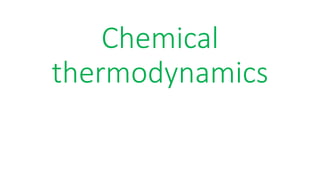
Thermodynamics ii
- 2. Spontaneous Process: In Thermodynamics sense, a process that occurs by itself without the help of external agent is a spontaneous process. All naturally occurring process is spontaneous process. Examples: 1. Rolling down of a stone downhill 2. Melting of ice 3. Flowing of water from higher to lower level 4. Vaporization of water 5. Burning of fuel 6. Mixing of gases 7. Natural radioactivity, etc.
- 3. Characteristics of Spontaneous Process: 1. All spontaneous process are unidirectional in nature and proceed till the process is completed or a state of equilibrium is reached 2. Some spontaneous process can be reversed by applying external agency. 3. Some spontaneous process requires initiations.
- 4. What is the driving force for spontaneous of a process? In the early development of thermodynamics energy change was considered as criteria for spontaneity a process occurs with decrease in energy is spontaneous. Example. flowing of water from higher to lower level, rolling down of stone downhill etc. In case of chemical reaction, the reaction that occurs with decrease in enthalpy i.e. exothermic is spontaneous like burning of Methane, neutralization reaction, etc. On the basis of enthalpy change, ∆H = -ve = exothermic = spontaneous ∆H = +ve = endothermic = non-spontaneous ∆ H = O = equilibrium
- 5. However many endothermic reaction were found to be spontaneous. Example, i. Melting of ice; H2O (s) → H2O (l) ∆H = +6 KJ ii. Vaporization of water H2O (l) → H2O (g) ∆H = +40.8 KJ iii. Dissociation of NH4NO3 in water, NH4NO3 (s) + H2O (l) → NH4 + (aq) + NO3 – (aq) ∆H = +25KJ These examples show that enthalpy change alone is not an enough criteria for spontaneity. These lead to necessity of another thermodynamic term. In all above examples, the molecular disorderness is increased, so the new thermodynamic function should measure disorderness. This function is called entropy.
- 6. Entropy: Entropy of a system is the measurement of disorderness or randomness of the system. The greater the randomness, the higher is the entropy. For a given substance, the crystalline solid state has lowest entropy i.e. in solid, the molecules are arranged orderly so it has least entropy but in liquid the disorderness is more than solid while in gas, the disorderness is maximum. So the order of entropy of a substance in different physical states, is, Ssolid < Sliquid << Sgas Entropy is a state function and depends only upon initial and final states, also change in entropy ( ∆s) will be Δ S = S2 – S1 Where S2 = Final state entropy S1 = Entropy of Initial state
- 7. In chemical reaction, the change in entropy is, Δ Sreaction = Sproducts – Sreactants = qrev, iso/T…………………..(i) ( simply Δ Sreaction = q/T) i.e. entropy change during the process is defined as the amount of heat (q) absorbed isothermally and reversibly (infinitesimally slowly) divided by the absolute temperature (T)
- 8. Justifications: 1. When a system absorbs heat, the molecule start moving faster because kinetic energy increases. Hence the disorder increases. More the heat absorbed, greater is the disorder. 2. For the same amount of heat absorbed at low temperature, the disorder is more than at higher temperature. Thus the presence of T in the denominator is justified. Unit Its unit is Jmol-1K-1
- 9. Limitation of the first law of thermodynamics. 1. First law does not provide a clear idea about the direction of absorption or evolution of heat. 2. The information provided by the first law of thermodynamics are not enough to predict the spontaneity or feasibility of a process. To deal with spontaneity of the chemical process some new terms viz., entropy and Gibbs free energy were introduced in thermodynamics which lead to the formulation of second law of the thermodynamics.
- 10. Second law of thermodynamics: There are limitation of first law of thermodynamics. To overcome those limitation and to explain the spontaneity of a process, second law of thermodynamics is stated. It state that, “ Whenever a spontaneous process takes place, it is accompanied by an increase in the total entropy of universe.” Thus for a spontaneous process ∆Suniverse = ∆Ssys + ∆Ssurr > 0 According to second law, when an irreversible spontaneous process occurs, the entropy of the system and surrounding increases. i.e. ∆Suniverse>0. As we consider entire universe as a system, the second law can be stated as, “ The entropy of the universe is constantly increasing.”
